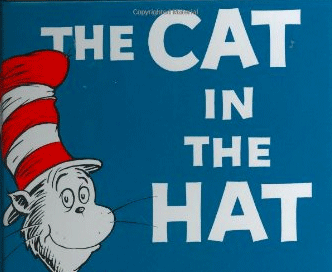Dr. Seuss, wicked constraints, and creative thinking
 One interesting theme in the research I’ve done on creative thinking is the role constraints play in fueling creativity. Many people find this paradoxical: shouldn’t having infinite resources and freedom make creativity easier? Well, besides the fact that supplies of infinite resources are hard to find, there’s plenty of evidence creative people get fuel from constraints.
One interesting theme in the research I’ve done on creative thinking is the role constraints play in fueling creativity. Many people find this paradoxical: shouldn’t having infinite resources and freedom make creativity easier? Well, besides the fact that supplies of infinite resources are hard to find, there’s plenty of evidence creative people get fuel from constraints.
One favorite example comes from Dr. Seuss. The book Cat in The Hat, and many of the books that followed, were born out of a requirement to only user 250 different words.
In May 1954, Life magazine published a report on illiteracy among school children, which concluded that children were not learning to read because their books were boring. Accordingly, Geisel’s publisher made up a list of 348 words he felt were important and asked Geisel [aka Dr. Seuss] to cut the list to 250 words and write a book using only those words. Nine months later, Geisel, using 236 of the words given to him, completed The Cat in the Hat. This book was a tour de force – it retained the drawing style, verse rhythms, and all the imaginative power of Geisel’s earlier works, but because of its simplified vocabulary could be read by beginning readers. These books achieved significant international success and remain very popular. (From wikipedia)
Of course this isn’t to say that all constraints are good. Some constraints make a solution impossible. If I asked you to build me a spaceship to Saturn that cost $5.50 and have it done by noon tomorrow, it’d be insane to criticize your lack of ability to find a solution by saying you’re not creative enough. But on the other hand, JFK’s proclamation to go put a man on the moon by 1970 seemed impossible to many when he said it in 1962.
The challenge is knowing how to define problems such that they provide enough constraints to help creativity, but not so many that creativity, or any solution, is impossible. The skill of defining requirements, the PM jargon for defining constraints and goals, is all too rare skill that doesn’t get the respect it deserves.
(See also, do constraints help creative thinking?)

I thought you made this point very well in your Innovation book (and here too). You should do a special presentation on “how to define the problem,” and business schools should be teaching this. Sometimes solving the problem itself becomes trivial if the question is defined properly. Often a strong problem definition leads to a more elegant solution. Cheers!
Cool post.
Art abounds with these examples – movements in symphony, metric in poetry, and so on.
On user interface design, same story. Certain constraints on how many UI elements you can have, a max number of widgets, that sort of thing can lead to great interfaces.
Disagree on the JFK example though – that’s not a constraint, that’s an audacious goal. Different concept imho.
cheers
Gustavo: You’re probably right on constraints vs. goals. Different but related.
(check spelling error in title)
This might be another example of the notion that you need something to start playing with (or against) before you can be inventive.
An unhappy example of a really general case is that literature and art have had periods of more inventive and vigorous growth when aggressive censorship has tried to eliminate them.
I am in the process of completing a musical for kids (of all ages) that overlaps with your thesis. The theme is based in discovering our own creative selves. The main teacher (one of the roles),the “teacher of the facts” posits that facts are what we need to learn to keep an orderly world. Another teacher (art teacher)objects, singing the song, “Facts Once Were Only Fancy”. The students (of various character types), ultimately challenge the teacher of the facts, as they explore Dr. Seuss stories. I would be interested in talking to you about the concept if you would like. I am presently about 10 songs into this and am now focusing on the story line.
Yes! I am a playwright and direct my plays. Obstacles force me to work out a new way to show the next progression in the story. When I could not find a male actor for my mad scientist in “Dr. Frankenstreudel’s Laboratory of Horrors”, I cast a female and that made the villain so much more evil. When I fired the boy I had cast for Harry in my Harry Potter parody two weeks before performance, I was able to split the part between two new actors, one boy, one girl, and explained it with a spell gone wrong in between them, and inserted that into other spells gone wrong that made an exciting spells gone wrong scene. When Dickens’ extensive narration in “A Christmas Carol” seemed to require a nearby Narrator which I did not want, I started ladling this kettle of narrations out in spoonfuls to nearby beggars and merchants, breaking the 4th wall to speak to the audience, which gave the supporting actors their moment in the spotlight. All of these were improvements. I simply cannot even start to create anything without restrictions telling me what I can not do.
Thanks for sharing this story about your work. Always interesting to hear how this idea applies to different kinds of creative work.